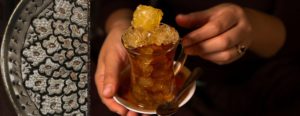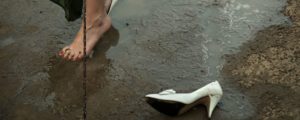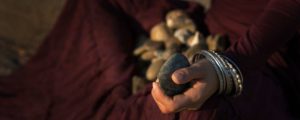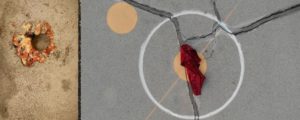
Pela primeira vez, o Fotograma Livre exibe obras de artistas iranianos. Dos quatro trabalhos inscritos, três foram selecionados como finalistas e entram na mostra 2019.
Em Bepar, Labkhand Olfatmanesh e a videomaker Gazelle Samizay exploram os desafios universais que as meninas enfrentam na transição para a vida adulta. Empregando uma referência cultural comum de amarelinha (chamada “lay lay” no Irã e “joz baazi” no Afeganistão), O personagem revive os momentos pessoais e políticos de seu passado, como guerra, casamento, traumas geracionais e expectativas sociais relacionadas ao gênero. As particularidades da experiência como mulheres de herança iraniana e afegã potencializaram a colaboração das artistas. Labkhand Olfatmanesh cresceu no Irã, e Gazelle Samizay nos EUA, mas o encontro foi a oportunidade de criar uma história comum enraizada em interseções culturais próprias.
Labkhand Olfatmanesh nasceu em Teerã, migrou para Chipre e atualmente vive em Los Angeles. Seu trabalho foi exibido em exposições individuais e coletivas, incluindo Photo London, UK; Rencontres d’Arles, França; a cultura Ataturk, Nicósia, Chipre; e o ofício contemporâneo, Los Angeles. Gazelle Samizay nasceu em Cabul (Afeganistão) e agora vive em Los Angeles. Suas fotografias e vídeos foram exibidos nos EUA e internacionalmente, inclusive na Whitechapel Gallery, em Londres; o Museu de Arte Latino-Americana, Long Beach; e o Slamdance Film Festival, Park City, UT. Atualmente, ela é a artista residente no Craft Contemporary and Level Ground, em Los Angeles. Além de sua prática de estúdio, sua escrita foi publicada em One Story, Trinta Histórias: Uma Antologia da Literatura Contemporânea Afegã-Americana. Samizay é uma beneficiária da Princesa Grace Experimental Film Honoraria e recebeu seu mestrado em fotografia na Universidade do Arizona.
Troquei alguns emails com Labbie Manesh e reproduzo aqui o texto dela.
My name is Labkhand (which means smile in Farsi) and I was born in Tehran, Iran in 1975.
As a young girl growing up in Tehran during the 1980’s, I was mesmerized by the arts and theater. My father’s side of the family was into singing, poetry and traditional Iranian music. As a child, I would play in front of the mirror channeling different personas and characters from films, and music that were attractive to me. Since I was very shy, I would often lose myself in the moment of these private shows! By age 12, I was getting serious as a painter and sculptor. And of course, I loved theater! Nevertheless, my family urged me towards studying something more conventional (i.e. boring).
After high school, I selected a graphic design program at Azad University in Tehran, which turned out to be a great choice. I tried different mediums and worked entirely analog since we were still a few years from desktop publishing. My photography teacher was very supportive and recognized my work, but unfortunately the way I chose to express myself did not have a place in Iran at the time. Nevertheless, I managed to create art for over ten solo and group exhibitions nationally and internationally. In 2003, I moved from Iran to the beautiful island of Cyprus and landed my first photography job at Contact Publishing, a British company that had two monthly magazines. As a staff photographer and style page editor, I stayed active with my art and worked with different international organizations and artists. Photography had truly become my voice, so I took a studio photography course in London to really expand my skills.
In 2006, I entered a few online competitions in various parts of the world. I was still living in Cyprus, but the thought of traveling really called me in a way I could not ignore. A few weeks later, I received an invitation from one of the competitions in the United States and I planned my trip as if I may never return. I won a second place prize and received a decent check for my efforts. That night, for the first time I thought wow, I really can be a great artist! Another perk from the contest and my body of work was my green card eligibility. Then I knew I had to stay here and continue the great adventure that started in front of my mirror.
Photography is my way of self-expressing. It allows me to highlight feelings and emotions I see in my subjects. My photographs also tend to reveal things about me. Be it fragments of life as an abstract form, or interactions with people I would otherwise not engage with, I am always striving for a clearer understanding of what’s around me. My camera has opened a world of new stories and unique self-expression.
- What is happening with Iranian women now, 40 years after Iranian revolution?
It’s hard to say. I have been out of Iran for 16 years so my information is second hand or from a few short trips when I visit friends and family. But I can tell you there are some improvements since my time living through the very dark ages of war, trauma, loss and taboos.
However, women are still fighting for their rights amidst barriers of deeply rooted traditions and family values. In patriarchal cultures like Iran, after a while you just forget to learn what your rights as a woman are and the lack of freedom becomes normalized, so that’s really hard for me to accept.
I had a hard time as a woman because I felt so powerless. That’s definitely the root of my anger and frustration growing up. I just could not accept this in any form, or for any reason because I believe in equality.
But in the United States there were new and different ways I was challenged by the power of men in the workplace, the media and politics. So things have improved, but a no matter where you live, woman’s struggle never ends.
- I could say Bepar (Hop) is about a woman’s transitions? What are the issues an Iranian girl have to face to become an adult women?
Growing up after the 1979 Iranian Revolution and during the dark ages of the Iran-Iraq war had a huge impact on Iranian girls and her past, such as war, marriage, generational trauma, and gendered social expectations. For example many friends my age do not have children including myself.
– How Gazella Samizay participated in Bepar (Hop) work?
Gazelle and I met two years ago at a group show we had both entered. She born in Kabul Afghanistan and moved out when she was 2 years old so talked about our common cultural backgrounds, immigration experiences, as well as family history and instantly became friends.
Eventually we talked about collaborating on a project, and that’s when we found out about an Iranian non-profit organization in Los Angeles called the Farhang Foundation that was having a call for entries. It was a perfect venue to show this film she and I created that explores the universal struggle young girls face as they grow into adulthood in a patriarchal society.
The main character relives the personal and political moments of her past, such as war, marriage, generational trauma, and gendered social expectations. The particularities of their experiences are as women of Afghan and Iranian heritage.
Reproduzo aqui as imagens que integram o Bepar. Não são dípticos. Estão exibidos alinhados por configuração do Blog 🙁















